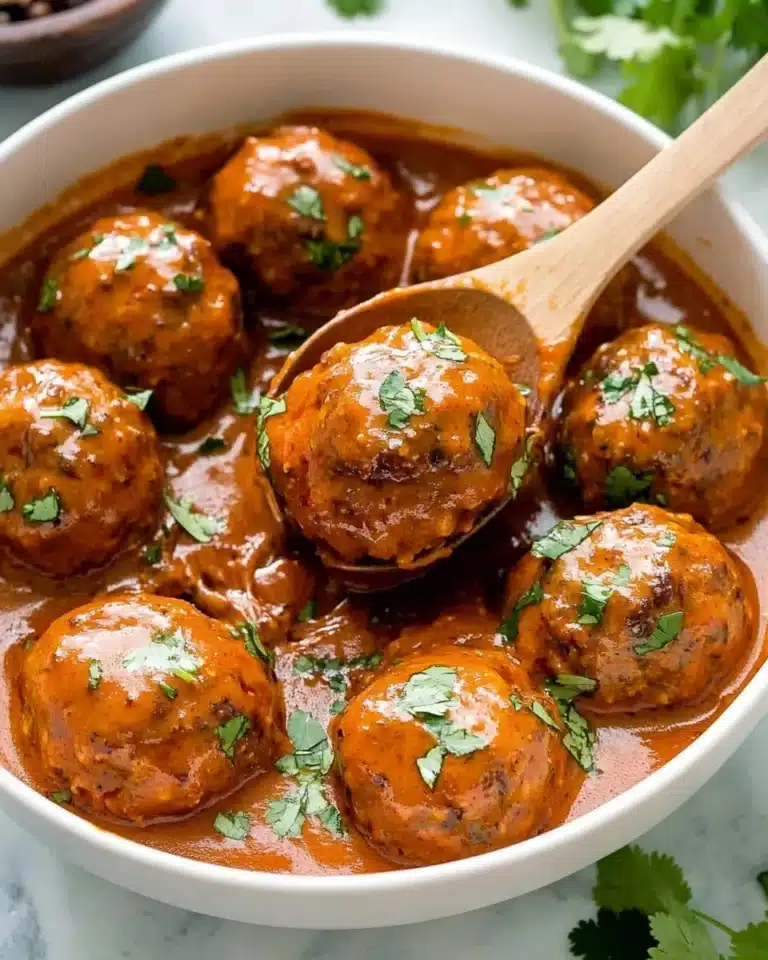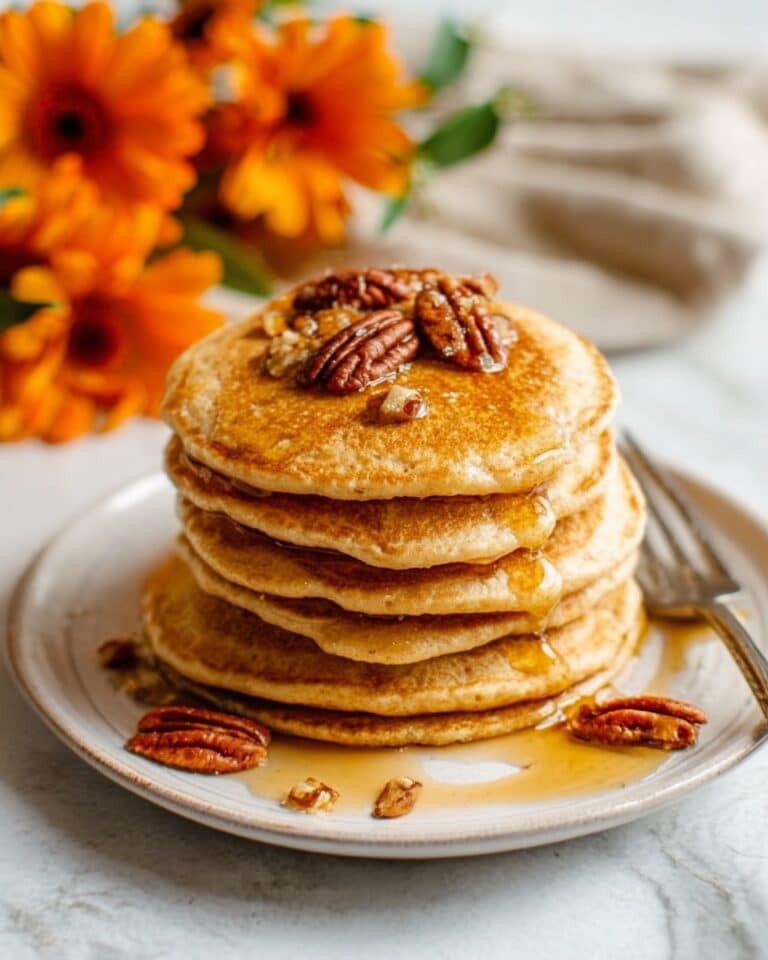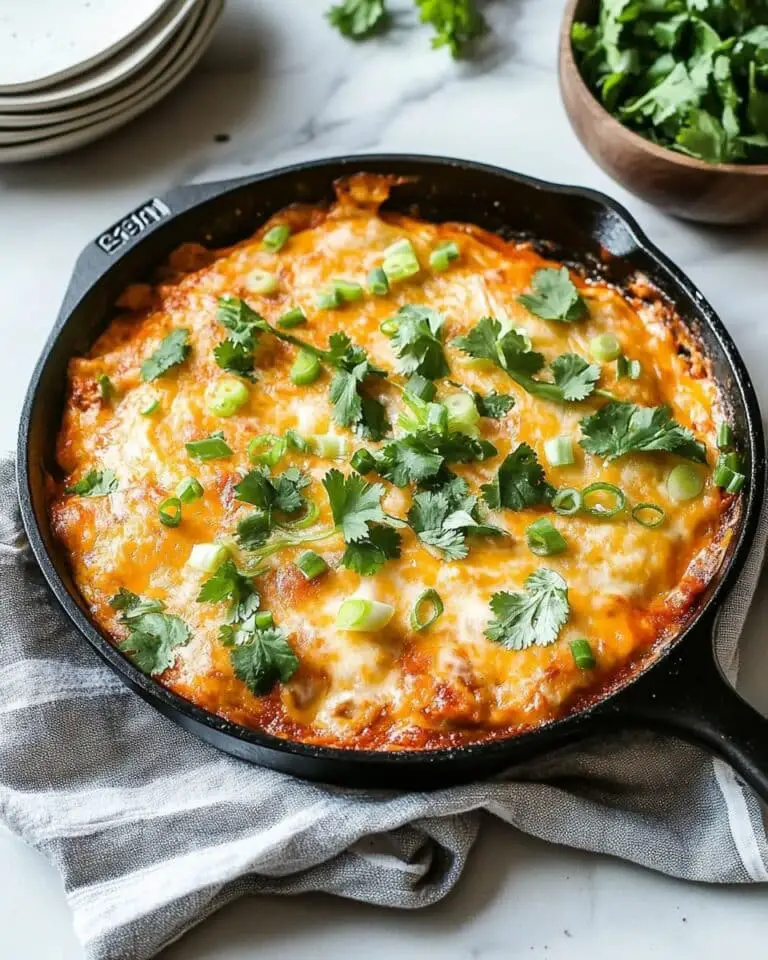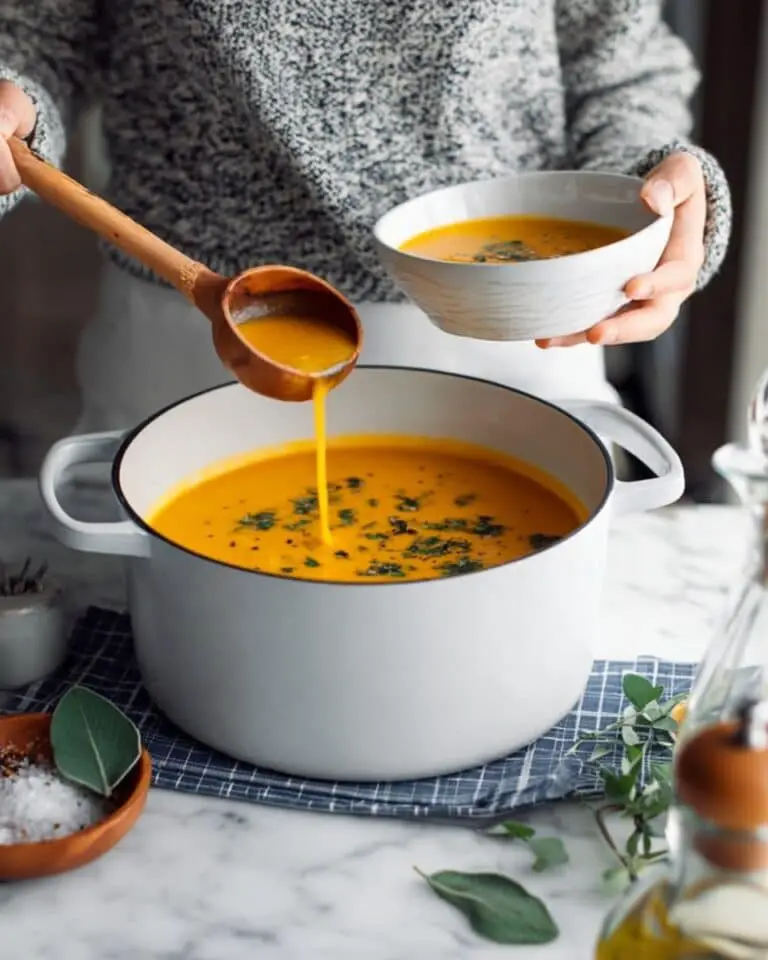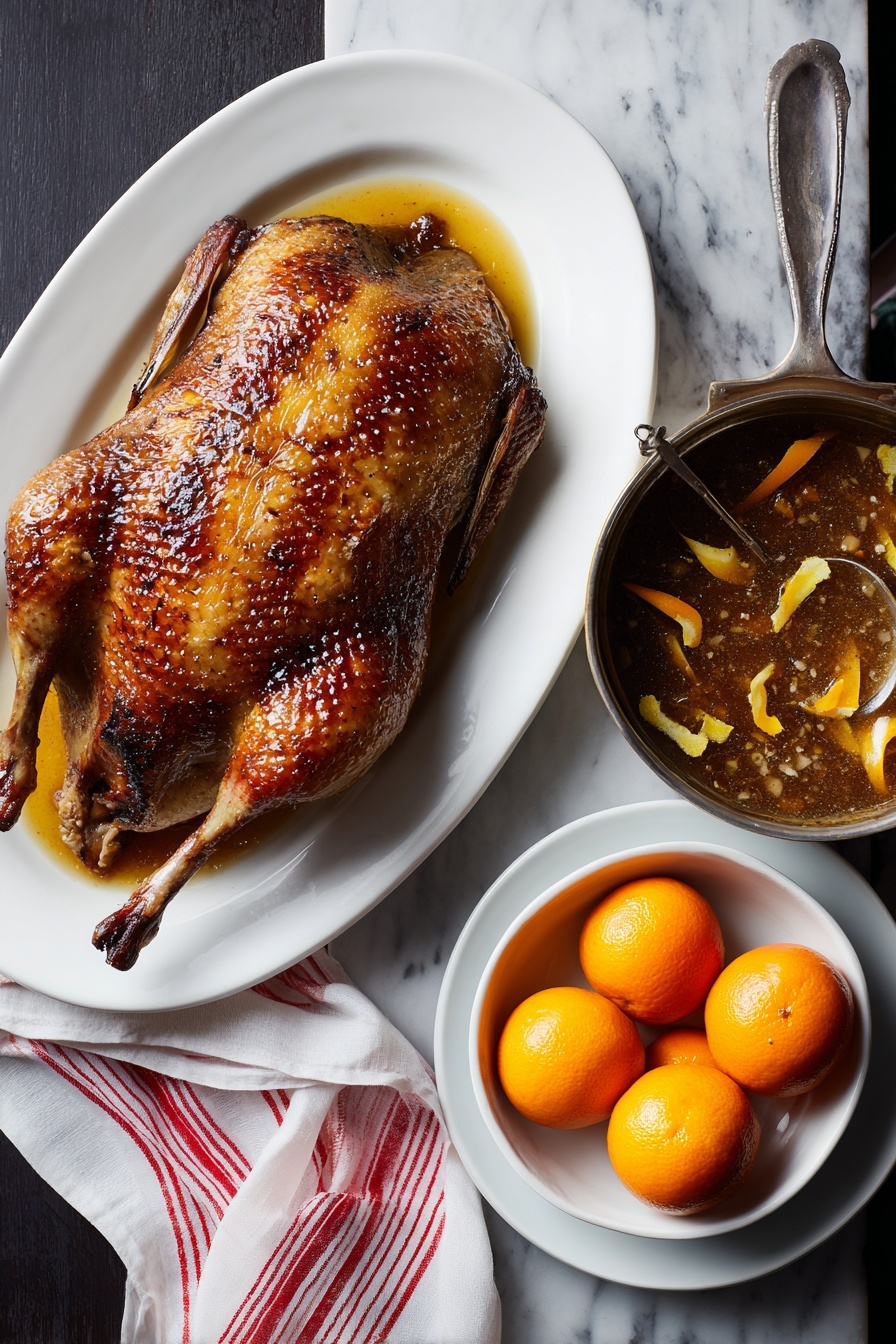
If you’re craving a dish that’s elegant but actually doable at home, you absolutely need to try my Duck à l’Orange Recipe. This classic French dish has been a favorite in my kitchen for years, and trust me when I say it’s worth every minute of prep and cooking time. The combination of crispy, succulent duck with a tangy, perfectly balanced orange sauce is pure magic—you’re going to love how the flavors come together, and your guests will be seriously impressed.
Why You’ll Love This Recipe
- Classic yet approachable: Duck à l’Orange might sound fancy, but with this recipe, you’ll see it’s totally achievable in your own kitchen.
- Perfect balance of flavors: The sweet and tangy orange sauce cuts through the rich duck, making each bite irresistible.
- Make-ahead sauce base: The stock and gastrique can be prepared in advance, giving you stress-free dinner planning.
- Crowd-pleaser: Whether it’s a special date night or holiday feast, this dish always wins big with family and friends.
Ingredients You’ll Need
To make this beautiful Duck à l’Orange Recipe come together, you’ll want good-quality ingredients that bring authentic flavor and richness — from the whole duck itself to fresh citrus and rich stock that forms the backbone of the sauce. Shopping tip: look for a duck with nice plump skin to help achieve that crispy finish.
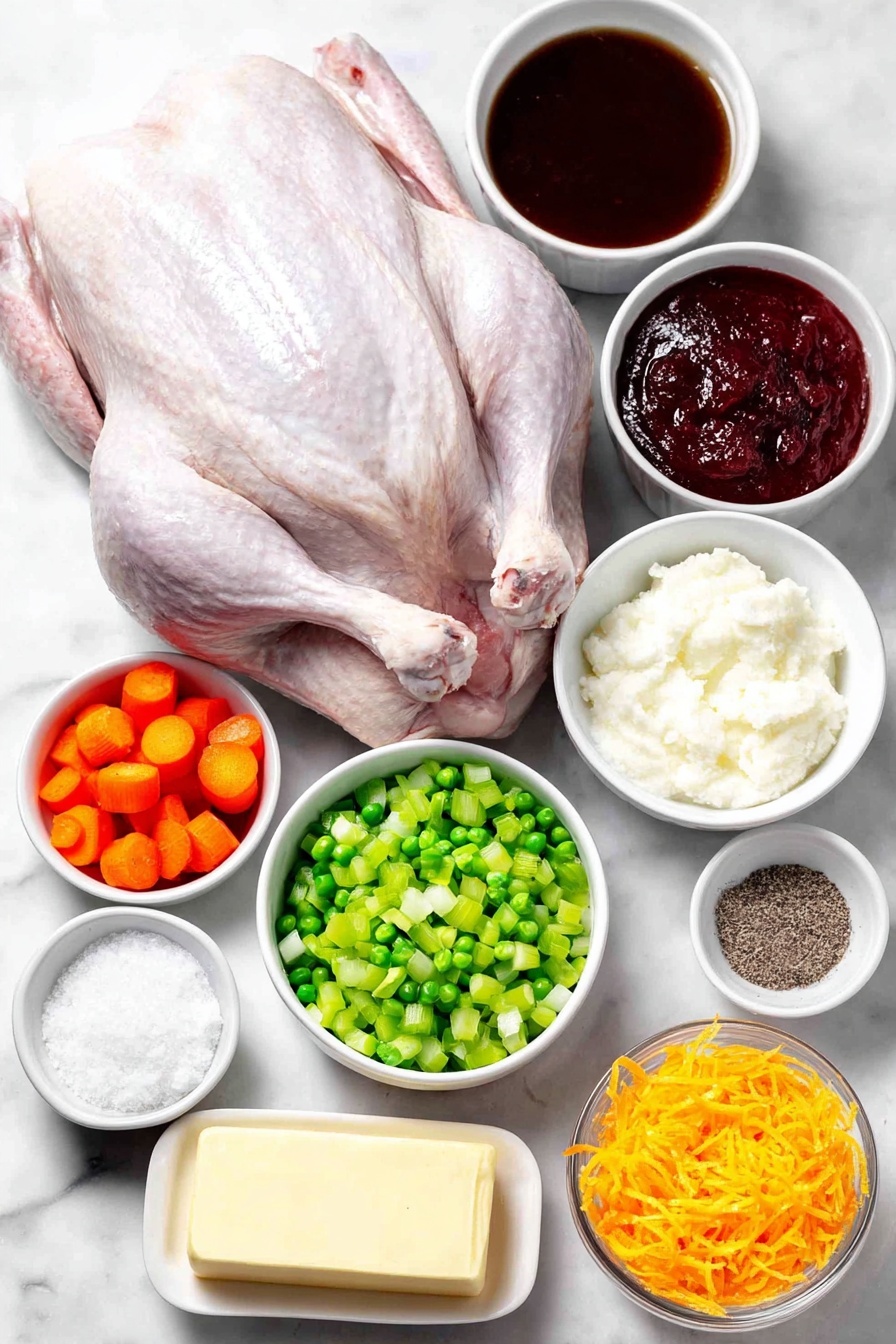
- Whole duck: About 5 pounds is ideal—you’ll want one that’s fresh or well-thawed for the best texture.
- Vegetable oil: Used to lightly coat vegetables and duck trimmings before roasting for deep browning.
- Kosher salt: Essential for seasoning and helping the skin crisp nicely.
- Carrot, onion, celery: Classic trinity of aromatics that build flavor in the stock for the sauce.
- Brown beef or chicken stock: This is the flavor base of your sauce, so use a good quality or homemade version.
- Tomato paste (optional): Helps deepen color and add umami to the stock—particularly helpful if your stock looks a bit pale.
- Granulated sugar: For making the caramelized gastrique that’s key to the sauce’s sweet-tart balance.
- Red wine vinegar: Adds the sharpness that beautifully contrasts the sweetness of the orange.
- Orange zest and juice: Fresh zest adds aromatic oils; fresh juice (navel or bitter orange) delivers bright citrus flavor.
- Fresh lemon juice: Brings acidity to brighten the sauce if you’re not using bitter orange juice.
- Butter: Incorporated at the end for a glossy, rich finish.
- Cornstarch or arrowroot (optional): Used only if the sauce needs thickening to perfect consistency.
Variations
I love how versatile this Duck à l’Orange Recipe can be. Over time, I’ve experimented with subtle tweaks to suit different occasions and palates—don’t hesitate to make it your own!
- Bitter orange swap: Using bitter oranges instead of navel oranges adds a unique depth and slightly more tartness, which I find gives the sauce a professional edge.
- Herb infusion: Sometimes I add fresh thyme or rosemary to the roasting pan. It adds a lovely herbaceous note that pairs beautifully without overpowering the orange.
- Spice twist: For a holiday flair, a pinch of cinnamon or star anise in the sauce works wonderfully to warm up the citrus flavors.
- Smaller portions: If you’re cooking for two, I’ve had great success halving the recipe and roasting duck breasts instead of a whole bird for a quicker, simpler meal.
How to Make Duck à l’Orange Recipe
Step 1: Prep and Prick for Crispy Skin
Start by trimming your duck—remove any excess skin around the neck and cavity openings, cut off wing tips but keep the drumettes attached. Don’t toss those trimmed wing ends and neck; they’ll come in handy for the sauce stock later! Prick the duck skin all over with a sharp paring knife—this step is crucial to render fat and get that crackling skin we all love. Be careful to just pierce the skin, not the meat.
Step 2: Blanching for Extra Crispness
Here’s a trick I discovered that makes a huge difference: dip the duck briefly in boiling water (about 2 minutes). I wear my trusty heavy kitchen gloves for this since it’s hot work. This quick blanch helps tighten the skin and encourages even crisping while roasting. After dunking, let the duck drain and dry before seasoning generously inside and out with kosher salt. Then, refrigerate uncovered for at least an hour. Overnight if you can—it dries out the skin beautifully.
Step 3: Roast Stock Ingredients and Make Stock
While the duck chills, preheat your oven to 425°F (220°C). Toss the trimmed wings and neck along with diced carrot, onion, and celery in a little oil (and tomato paste if you’re using it) on a rimmed baking sheet. Roast until beautifully browned, about 25 minutes. These roasted bits add incredible flavor to your sauce stock. Transfer them to a large saucepan, pour in your brown stock, and deglaze the baking sheet with boiling water to scoop up all those browned bits—don’t miss that step! Let this simmer until reduced by about half. It takes patience but believe me, it’s worth it for the concentrated flavor.
Step 4: Roast the Duck to Perfection
Increase the oven temperature to 450°F (230°C), then roast the duck (still on the wire rack so fat can drip away) for 30 minutes. Fair warning: this part can produce a bit of smoke, so ventilate your kitchen well! Once the skin starts to crisp, lower the heat to 300°F (150°C) and continue roasting until the meat reaches about 175°F internally, ensuring it’s fully cooked but still juicy. For spatchcocked ducks, this takes about 45 minutes more; for whole ducks, closer to an hour. When done, let the duck rest—not only does this help retain moisture, but it also allows the skin to firm up beautifully.
Step 5: Create the Signature Orange Sauce
While the duck roasts, make your orange gastrique. I’ve found that cooking the sugar and water slowly to a deep amber caramel—around 6 to 10 minutes depending on your stove—is key. Then, very carefully add red wine vinegar a little at a time to prevent boiling over. Once the sauce calms, simmer to thicken slightly. Meanwhile, blanch your orange zest in boiling water to soften and mellow any bitterness—about 2 minutes for navel orange, longer for bitter oranges.
Step 6: Finish the Sauce and Serve
Combine your reduced stock with fresh orange and lemon juice, then simmer until it coats the back of a spoon. Slowly whisk in your prepared gastrique—be careful not to overpower the sauce; two to four teaspoons usually hits the sweet spot. Stir in butter off the heat for a velvety finish. If it’s too thin, a tiny bit of cornstarch slurry helps you get the perfect thickness. Add your softened orange zest at the end for that bright, fresh aroma. Before serving, pop the duck back into the oven for a quick reheat to crisp the skin again, then carve and spoon that gorgeous sauce all over. Divine.
Pro Tips for Making Duck à l’Orange Recipe
- Don’t skip the skin prick: Piercing the skin allows fat to render out during roasting, which is crucial for that crisp texture.
- Control your caramel color: Watch the sugar carefully as it caramelizes—the difference between light and deep amber changes the flavor profile of your gastrique.
- Use residual heat smartly: Resting the duck lets the juices redistribute, so carve only just before serving to keep the meat juicy.
- Adjust acidity cautiously: The sauce is all about balance—add vinegar and citrus juice slowly to avoid overwhelming the delicate sweet-tart harmony.
How to Serve Duck à l’Orange Recipe
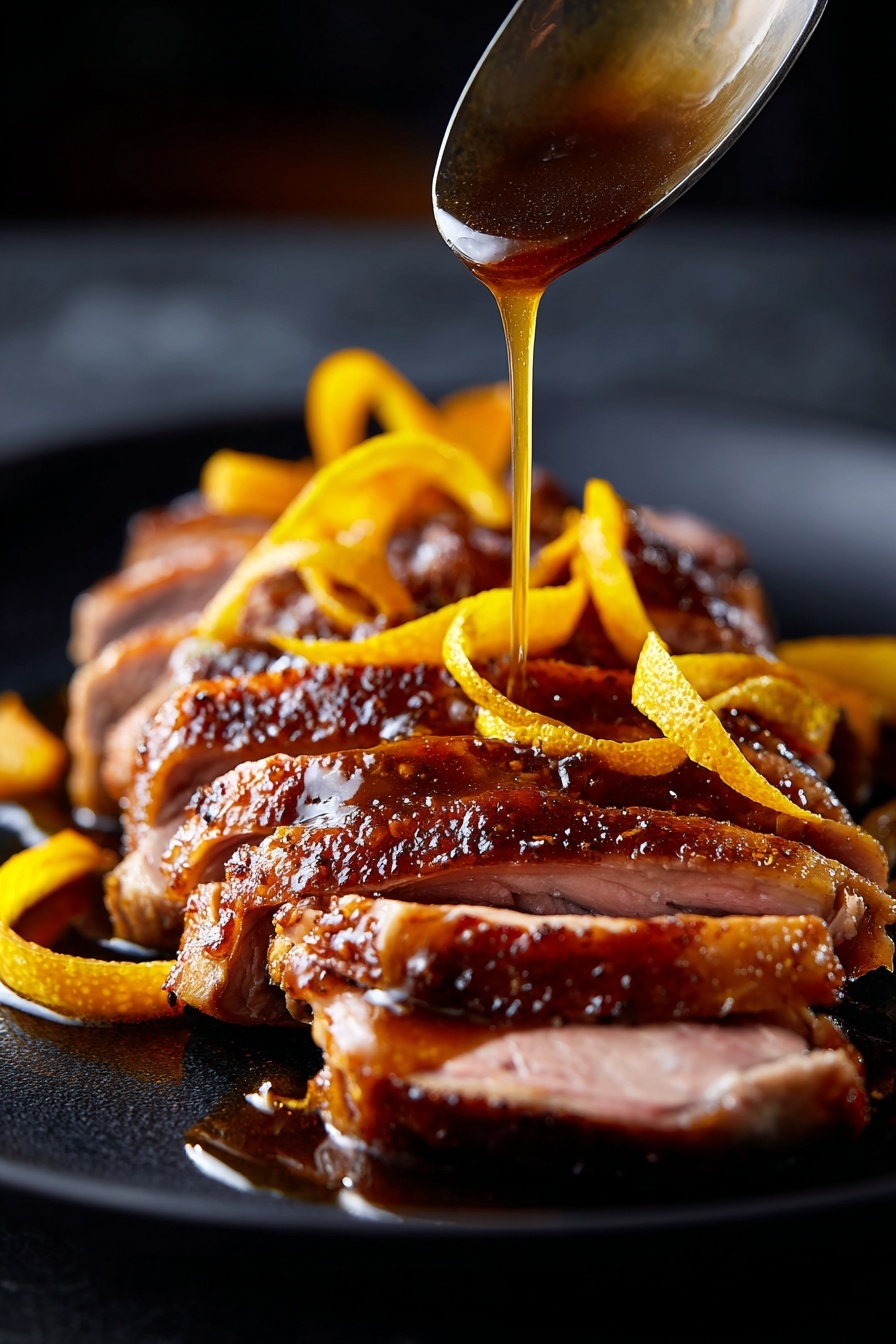
Garnishes
I typically garnish with a few fresh orange segments and a sprig of fresh thyme or parsley. It adds a vibrant color contrast and a hint of herbal freshness that complements the sweet citrus sauce perfectly. Some caramelized orange slices on top can also add a dramatic flair for guests.
Side Dishes
My go-to sides include creamy mashed potatoes or a silky parsnip purée to soak up that luscious sauce. Roasted Brussels sprouts or green beans tossed with a bit of lemon zest and almonds make a crisp, bright counterpart to the richness of the duck.
Creative Ways to Present
For special occasions, I like to plate the carved duck breast fanned out over a smear of the sauce, with the roasted vegetables beautifully arranged alongside. Drizzle extra gastrique in delicate dots around the plate for a restaurant-style touch. If you’re feeling fancy, a small edible flower or microgreens can add a surprising pop of elegance.
Make Ahead and Storage
Storing Leftovers
Leftover duck tastes great the next day! I tightly wrap any unused meat and keep it in an airtight container in the fridge for up to 2 days. The sauce stores separately in a sealed jar, which helps maintain its brightness and texture.
Freezing
I’ve tried freezing cooked leftover duck and sauce separately, and it works well for up to 3 months. Just thaw overnight in the fridge before reheating gently.
Reheating
To reheat, warm the duck slowly in a low oven (about 275°F) covered loosely with foil to keep it moist and prevent the skin from getting rubbery. Heat the sauce gently on the stovetop, whisking in a little butter if needed to bring back its silkiness.
FAQs
-
Can I use duck breasts instead of a whole duck for this Duck à l’Orange Recipe?
Absolutely! Duck breasts are much quicker to cook and are perfect if you want the flavors of Duck à l’Orange without the longer roasting time. Just score the skin, season, and roast or pan-sear until the skin is crisp and the meat is medium-rare to medium. Adjust sauce quantities accordingly.
-
What’s the secret to crispy duck skin in this recipe?
Pricking the skin, blanching the duck briefly in boiling water, and leaving it uncovered in the fridge to dry out are all essential steps I swear by. Also, roasting first at a high temperature and then lowering the heat helps fat render without burning the skin.
-
Can I make the orange sauce ahead of time?
Yes! The sauce components, including the stock and gastrique, can be made a day or two ahead. Just keep the sauce refrigerated in an airtight container and gently reheat while whisking in fresh butter before serving.
-
What if my sauce is too thin or too thick?
If it’s too thin, a cornstarch or arrowroot slurry can help you thicken it gently without losing flavor. If it gets too thick, stir in a little more stock or orange juice to loosen it up.
Final Thoughts
Making this Duck à l’Orange Recipe is like treating yourself to a little piece of French culinary heaven right at home. I love serving it when I want to wow my family without spending all day in the kitchen—and the best part? Everyone always asks for seconds. With its balance of crispy skin, tender meat, and that tangy-sweet sauce, it truly feels special. I hope you give it a try and enjoy it as much as I do. Happy cooking!
Print
Duck à l’Orange Recipe
- Prep Time: 25 minutes
- Cook Time: 5 hours
- Total Time: 5 hours 25 minutes
- Yield: 4 servings
- Category: Main Course
- Method: Roasting
- Cuisine: French
Description
Duck à l’Orange is a classic French dish featuring tender, roasted duck served with a vibrant, tangy orange sauce. This recipe walks the fine line of flavors by balancing the rich, crispy duck with a beautifully reduced sauce made from roasted duck trimmings, citrus juice, and a sweet-sour caramel gastrique. It’s a perfect celebratory meal that combines roasting and stovetop sauce preparation for a sophisticated yet approachable dish.
Ingredients
Duck Preparation
- 1 whole duck (about 5 pounds; 2.25kg)
- Vegetable oil, for drizzling
- Kosher salt
Vegetables for Stock
- 1 medium carrot, diced
- 1 medium yellow onion, diced
- 1 large celery rib, diced
Stock and Flavorings
- 2 quarts (2 liters) brown beef or brown chicken stock
- 1 tablespoon (15ml) tomato paste (optional)
Gastrique Ingredients
- 4 ounces (115g) granulated sugar (about 1/2 cup plus 1 tablespoon)
- 1/2 cup red wine vinegar
Citrus Ingredients
- Zest of 1 navel orange or 2 bitter oranges, cleaned of any white pith and cut into a fine julienne
- 2 tablespoons (30ml) fresh navel orange juice or 1/4 cup (60ml) bitter orange juice
- 2 tablespoons fresh lemon juice (omit if using bitter orange juice)
Seasoning and Finishing
- Freshly ground white or black pepper
- 2 tablespoons (30g) cold unsalted butter
- Cornstarch or arrowroot (optional, only if needed)
Instructions
- Spatchcock the Duck (optional)
Use poultry shears to remove the backbone by cutting along both sides of the spine, then flip the duck and press down on the breast to flatten it. This step is optional but helps with even roasting. - Trim and Prepare Duck
Trim excess skin from the neck and cavity openings. Cut off wingettes and wing tips at the joint, leaving drumettes attached. Remove neck and giblets from cavity. Refrigerate neck, trimmed wings, and spine for sauce stock; save or discard giblets and skin. - Prick Duck Skin and Blanch
Prick skin all over with a sharp knife without cutting the meat. Wearing heat-safe gloves, dip the duck in boiling water for 2 minutes. Drain well and place breast side up on a wire rack over a rimmed baking sheet. - Salt and Refrigerate
Season duck thoroughly inside and out with kosher salt. Refrigerate uncovered for 1 to 24 hours to dry the skin for crispiness. - Preheat Oven and Roast Trimmings
Preheat oven to 425°F (220°C). On a rimmed baking sheet, toss trimmed wings, neck, (and backbone if using) with diced carrots, onions, celery, and a drizzle of vegetable oil. Optionally rub tomato paste over duck and vegetables. Roast until browned, about 25 minutes, stirring occasionally and avoiding burning. - Simmer Stock
Transfer roasted trimmings and vegetables to a large saucepan with the brown stock. Add boiling water to baking sheet, scrape browned bits, and add to the stock. Simmer gently for 1-2 hours, skimming scum and fat frequently to reduce by half. - Strain and Reduce Stock
Strain the stock through a fine mesh sieve, discard solids, and return liquid to a smaller pan. Simmer gently until reduced to about 1 cup (225ml), about 1-1.5 hours, skimming as needed. Set aside. - Roast the Duck
Increase oven temperature to 450°F (230°C). Place duck on wire rack in rimmed tray and roast for 30 minutes to render fat and crisp skin. Then reduce oven to 300°F (150°C) and roast until internal temperature reaches 175°F (79°C) in thickest parts, approximately 45 minutes for spatchcocked duck or 1 hour for whole duck. Remove and rest. - Prepare Gastrique
In a small saucepan, combine sugar and 1/4 cup water, heat over medium stirring until boiling. Simmer without stirring until syrup turns a deep amber color (7-10 minutes total). Remove from heat and slowly add red wine vinegar in small increments while swirling to avoid boil over. Return to heat, boil briefly, then reduce and simmer 2 minutes. Set aside. - Blanch Orange Zest
Boil about 1 cup water in a clean small saucepan. Add orange zest and simmer 2 minutes for navel orange zest or 15 minutes for bitter orange zest. Drain and set aside. - Reheat Duck
Before serving, return duck to oven for 5-15 minutes to reheat and re-crisp skin. - Make Orange Sauce
Combine navel orange juice and lemon juice (or bitter orange juice if used) with reduced stock in a saucepan, bring to simmer over medium heat. Reduce until sauce thickly coats the back of a spoon, about 5 minutes. - Adjust Sauce Flavor
Add gastrique 1 teaspoon at a time, tasting to achieve a balanced sweet-sour profile without overpowering sharpness. You will only need 2-4 teaspoons. Season with salt and pepper. - Finish Sauce
Whisk in cold butter over very low heat until silky. If sauce is too thin, make a cornstarch or arrowroot slurry and whisk in, simmering briefly to thicken. Add blanched orange zest and simmer gently for 1 minute to infuse flavor. - Serve
Carve duck and spoon sauce generously on top or alongside.
Notes
- The sauce is carefully balanced to cut through the rich flavor of the duck without overpowering it, making this dish elegant and delicious.
- Spatchcocking the duck helps achieve a more even, faster roasting but is optional.
- Tomato paste in the stock is optional and adds a deeper color to the sauce.
- Careful handling of the caramel and vinegar mixture is key when making the gastrique to prevent boil overs.
- Use a meat thermometer to ensure the duck is fully cooked; it should reach 175°F in the thickest parts.
Nutrition
- Serving Size: Serves 2 to 4 as a main course
- Calories: 2323 kcal
- Sugar: 41 g
- Sodium: 1525 mg
- Fat: 176 g
- Saturated Fat: 61 g
- Unsaturated Fat: 0 g
- Trans Fat: 0 g
- Carbohydrates: 56 g
- Fiber: 2 g
- Protein: 121 g
- Cholesterol: 506 mg


